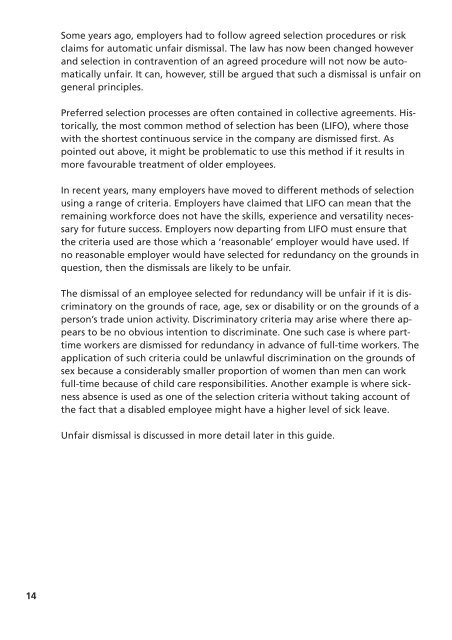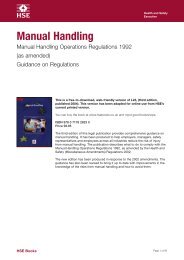Redundancy - Unite the Union
Redundancy - Unite the Union
Redundancy - Unite the Union
Create successful ePaper yourself
Turn your PDF publications into a flip-book with our unique Google optimized e-Paper software.
Some years ago, employers had to follow agreed selection procedures or risk<br />
claims for automatic unfair dismissal. The law has now been changed however<br />
and selection in contravention of an agreed procedure will not now be automatically<br />
unfair. It can, however, still be argued that such a dismissal is unfair on<br />
general principles.<br />
Preferred selection processes are often contained in collective agreements. Historically,<br />
<strong>the</strong> most common method of selection has been (LIFO), where those<br />
with <strong>the</strong> shortest continuous service in <strong>the</strong> company are dismissed first. As<br />
pointed out above, it might be problematic to use this method if it results in<br />
more favourable treatment of older employees.<br />
In recent years, many employers have moved to different methods of selection<br />
using a range of criteria. Employers have claimed that LIFO can mean that <strong>the</strong><br />
remaining workforce does not have <strong>the</strong> skills, experience and versatility necessary<br />
for future success. Employers now departing from LIFO must ensure that<br />
<strong>the</strong> criteria used are those which a ‘reasonable’ employer would have used. If<br />
no reasonable employer would have selected for redundancy on <strong>the</strong> grounds in<br />
question, <strong>the</strong>n <strong>the</strong> dismissals are likely to be unfair.<br />
The dismissal of an employee selected for redundancy will be unfair if it is discriminatory<br />
on <strong>the</strong> grounds of race, age, sex or disability or on <strong>the</strong> grounds of a<br />
person’s trade union activity. Discriminatory criteria may arise where <strong>the</strong>re appears<br />
to be no obvious intention to discriminate. One such case is where parttime<br />
workers are dismissed for redundancy in advance of full-time workers. The<br />
application of such criteria could be unlawful discrimination on <strong>the</strong> grounds of<br />
sex because a considerably smaller proportion of women than men can work<br />
full-time because of child care responsibilities. Ano<strong>the</strong>r example is where sickness<br />
absence is used as one of <strong>the</strong> selection criteria without taking account of<br />
<strong>the</strong> fact that a disabled employee might have a higher level of sick leave.<br />
Unfair dismissal is discussed in more detail later in this guide.<br />
14

















